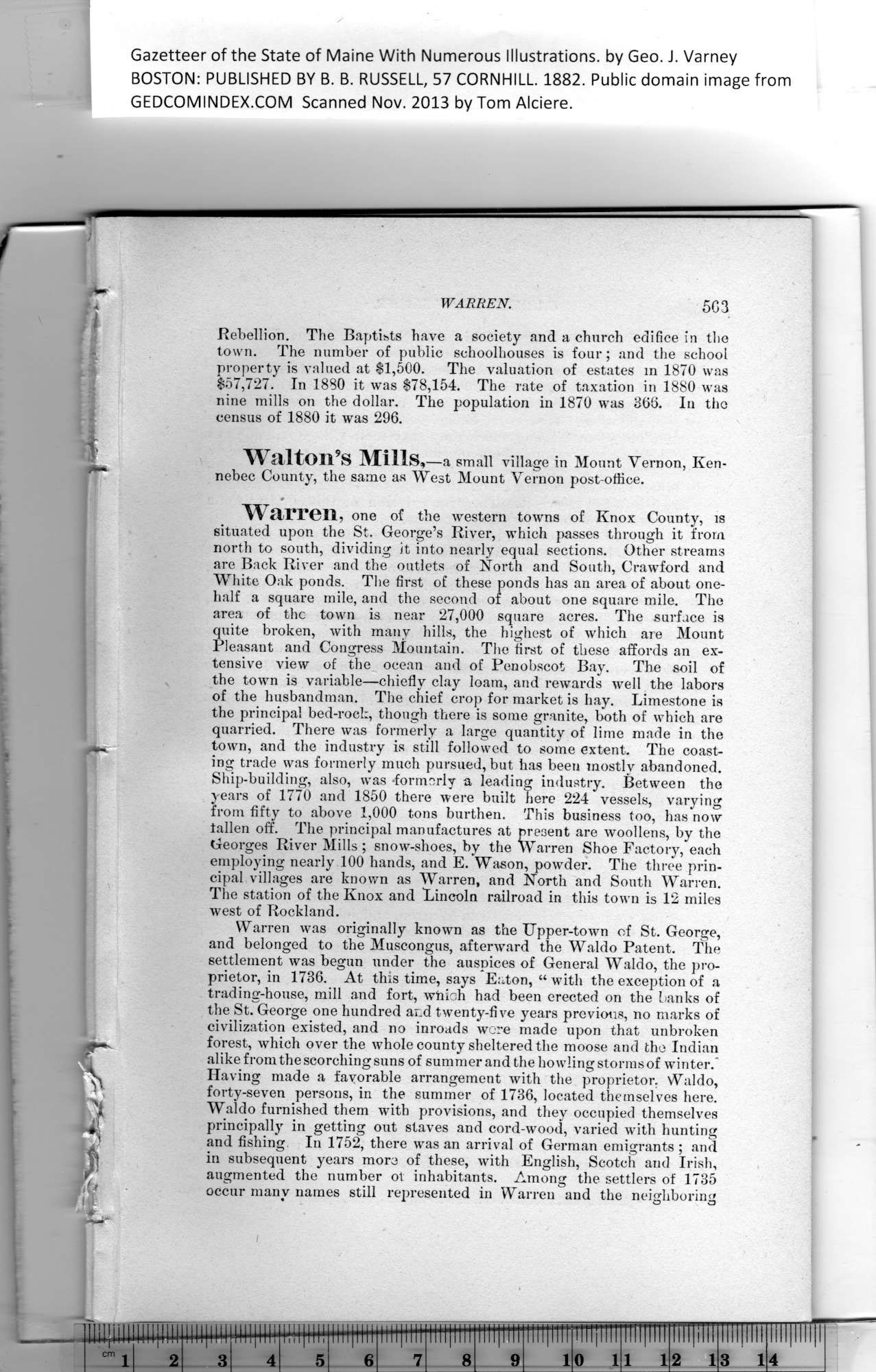|
Gazetteer of the State of Maine With Numerous Illustrations, by Geo. J. Varney
BOSTON: PUBLISHED BY B. B. RUSSELL, 57 CORNHILL. 1882. Public domain image from
WARREN. 5G3
Rebellion. The Baptists have a society and a church edifice in the
town. The number of public schoolhouses is four; and the school
property is valued at $1,500. The valuation of estates m 1870 was
$57,727. In 1880 it was $78,154. The rate of taxation in 1880 was
nine mills on the dollar. The population in 1870 was 366. In tho
census of 1880 it was 296.
Walton’s Mills, —a small village in Mount Vernon, Ken-
nebec County, the same as West Mount Vernon post-office.
Warren, one of the western towns of Knox County, is
situated upon the St. George’s River, which passes through it from
north to south, dividing it into nearly equal sections. Other streams
are Back River and the outlets of North and South, Crawford and
White Oak ponds. The first of these ponds has an area of about one-
half a square mile, and the second of about one square mile. The
area of the town is near 27,000 square acres. The surface is
quite broken, with many hills, the highest of which are Mount
Pleasant and Congress Mountain. The first of these affords an ex-
tensive view of the ocean and of Penobscot Bay. The soil of
the town is variable—chiefly clay loam, and rewards well the labors
of the husbandman. The chief crop for market is hay. Limestone is
the principal bed-rock, though there is some granite, both of which are
quarried. There was formerly a large quantity of lime made in the
town, and the industry is still followed to some extent. The coast-
ing trade was formerly much pursued, but has been mostly abandoned.
Ship-building, also, was formerly a leading industry. Between the
years of 1770 and 1850 there were built here 224 vessels, varying
from fifty to above 1,000 tons burthen. This business too, has now
fallen off. The principal manufactures at present are woollens, by the
Georges River Mills; snow-shoes, by the Warren Shoe Factory, each
employing nearly 100 hands, and E. Wason, powder. The three prin-
cipal villages are known as Warren, and North and South Warren.
The station of the Knox and Lincoln railroad in this town is 12 miles
west of Rockland.
Warren was originally known as the Upper-town of St. George,
and belonged to the Muscongus, afterward the Waldo Patent. The
settlement was begun under the auspices of General Waldo, the pro-
prietor, in 1736. At this time, says Eaton, “ with the exception of a
trading-house, mill and fort, which had been erected on the banks of
the St. George one hundred and twenty-five years previous, no marks of
civilization existed, and no inroads wore made upon that unbroken
forest, which over tbe whole county sheltered the moose and the Indian
alike from the scorching suns of summer and the howling storms of winter."
Having made a favorable arrangement with the proprietor. Waldo,
forty-seven persons, in the summer of 1736, located themselves here.
Waldo furnished them with provisions, and they occupied themselves
principally in getting out staves and cord-wood, varied with hunting
and fishing In 1752, there was an arrival of German emigrants ; and
in subsequent years more of these, with English, Scotch and Irish,
augmented the number ot inhabitants. Among the settlers of 1735
occur many names still represented in Warren and the neighboring
PREVIOUS PAGE ... NEXT PAGE
This page was written in HTML using a program written in Python 3.2
|
